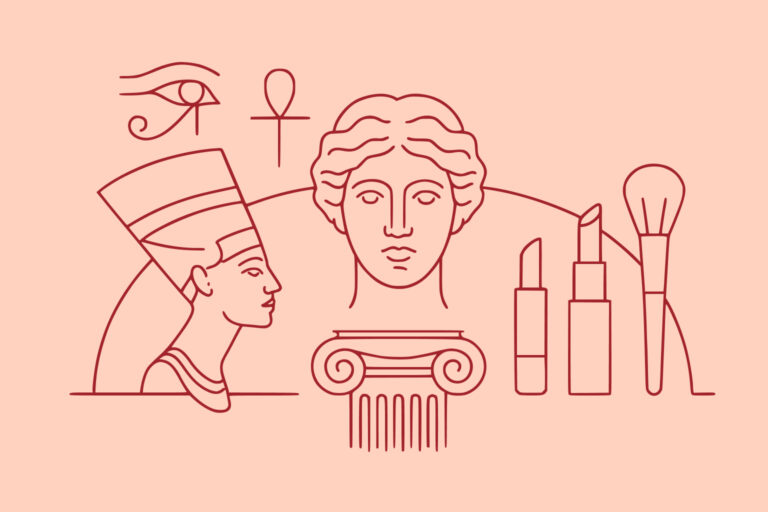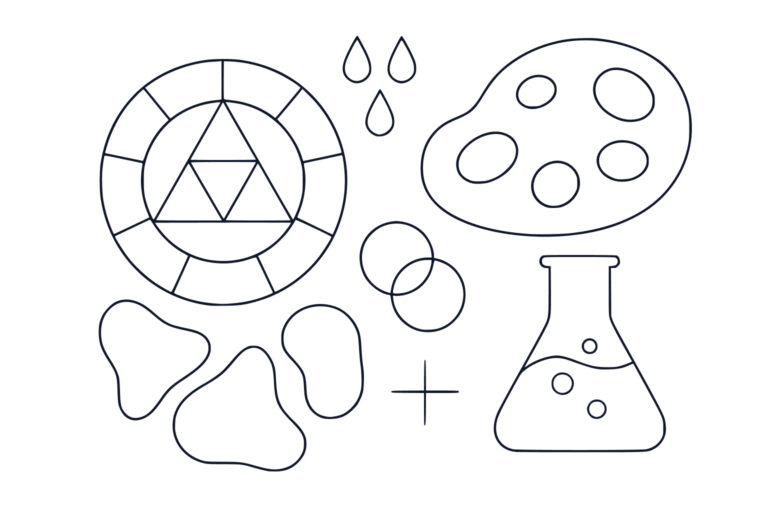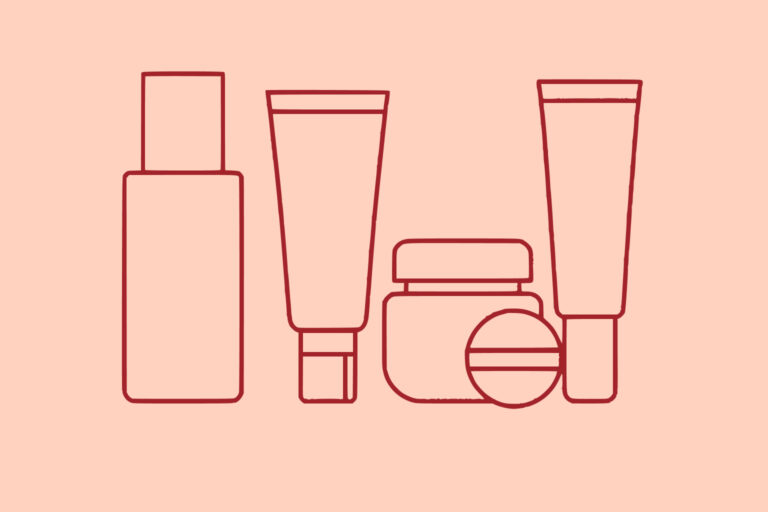Tudor Makeup and Renaissance Beauty: The Dangerous Pursuit of Perfection
Published by Professional Makeup Artist London
The Tudor period, spanning from 1485 to 1603, represents one of the most fascinating and dangerous eras in makeup history. During this time, beauty standards reached extraordinary heights of artifice, with men and women alike pursuing an ideal of pale, porcelain perfection that often came at a deadly cost. From Queen Elizabeth I’s iconic white face to the elaborate beauty rituals of the Renaissance court, Tudor makeup tells a story of vanity, status, and the lengths people would go to achieve fashionable beauty.
The Tudor Beauty Ideal: Pale Perfection
The Tudor beauty standard was dramatically different from today’s sun-kissed ideals. Pale, almost translucent skin was the ultimate goal, representing nobility, purity, and wealth. This preference stemmed from practical and social considerations—tanned skin indicated outdoor labour and lower social status, whilst pale skin suggested a life of leisure and refinement.
The ideal Tudor woman possessed several key features that defined Renaissance beauty. A high, broad forehead was considered the height of intelligence and nobility, often achieved by plucking the hairline to create an artificially elongated brow. Small, rosebud lips painted in subtle coral or pink tones suggested modesty and virtue. Wide-set eyes under thin, barely visible eyebrows created an ethereal, otherworldly appearance. Most importantly, skin had to be pale as porcelain, smooth as marble, and completely unblemished.
This beauty standard wasn’t limited to women. Tudor men, particularly those at court, also embraced cosmetics and elaborate grooming rituals. The pursuit of pale skin, refined features, and fashionable appearance was considered essential for anyone seeking advancement in Renaissance society.
Understanding these historical beauty ideals helps modern makeup artists appreciate how colour theory and cultural preferences have evolved whilst recognising the timeless human desire for beauty and self-expression.
Venetian Ceruse: The Deadly Foundation
The most famous and dangerous cosmetic of the Tudor era was Venetian ceruse, a white foundation made from white lead and vinegar. This toxic concoction was the Renaissance equivalent of modern foundation, promising the coveted pale complexion that defined fashionable beauty.
The preparation of Venetian ceruse was a complex and hazardous process. White lead was ground into a fine powder and mixed with vinegar to create a smooth, paint-like consistency. The mixture was then applied thickly to the face and neck, creating an artificial mask of white perfection. Some formulations included additional ingredients like egg whites for binding, crushed pearls for luminosity, or even arsenic for extra whitening power.
The application process required considerable skill and patience. The ceruse had to be applied evenly to avoid streaking or patchiness, often requiring multiple layers to achieve the desired opacity. Once applied, the wearer had to be careful not to smile too broadly or make excessive facial expressions, as this could crack the rigid surface and reveal the natural skin beneath.
Queen Elizabeth I became the most famous user of Venetian ceruse, applying it so thickly that contemporary accounts describe her face as resembling a painted mask. As she aged and her natural skin deteriorated from years of lead poisoning, she required increasingly heavy applications to maintain her iconic appearance.
The health consequences of regular ceruse use were devastating. Lead poisoning caused hair loss, tooth decay, skin damage, and eventually death. Many Tudor beauties suffered from what we now recognise as chronic lead toxicity, experiencing symptoms like fatigue, joint pain, and neurological problems. The irony was that the very product meant to enhance beauty ultimately destroyed it, creating a vicious cycle where heavier applications were needed to cover the damage caused by previous use.
Tudor Cosmetic Ingredients and Formulations
Beyond the infamous ceruse, Tudor cosmetics employed a fascinating array of ingredients, many of which would be considered bizarre or dangerous by modern standards. Understanding these formulations provides insight into Renaissance chemistry and the lengths people would go to achieve fashionable beauty.
For achieving the desired pale complexion, alternatives to ceruse included rice powder mixed with ground pearls for a luminous finish, chalk and white clay for a matte appearance, and crushed eggshells combined with honey for a smoother texture. These alternatives were safer than lead-based products but still carried risks, particularly when mixed with other chemicals.
Lip colour in the Tudor period was subtle and carefully applied. Popular formulations included beeswax mixed with red ochre for a natural tint, crushed cochineal insects combined with alum for a deeper red, and plant-based dyes from madder root or brazilwood for various pink tones. The application had to be precise, as the ideal lip shape was small and perfectly defined, often requiring the natural lip line to be covered with foundation and redrawn in a smaller, more fashionable shape.
Eye makeup was minimal but significant in the Tudor period. Kohl made from antimony or soot was used sparingly to define the eyes, whilst eyebrows were often plucked to near-invisibility or covered entirely with foundation. Some women used belladonna drops to dilate their pupils, creating a dreamy, ethereal appearance that was considered highly attractive despite the obvious health risks.
Cheek colour was achieved through various means, including pinching or slapping the cheeks for natural redness, applying rouge made from crushed berries or red clay, and using cochineal-based preparations for a more intense colour. The application had to appear natural, as obvious makeup was considered vulgar and inappropriate for respectable women.
The Social Significance of Tudor Makeup
Makeup in Tudor society served purposes far beyond mere vanity. It was a complex system of social signalling that communicated wealth, status, virtue, and political allegiance. Understanding these social dimensions helps us appreciate how cosmetics functioned as a form of non-verbal communication in Renaissance culture.
The expense of quality cosmetics made them accessible only to the wealthy. Venetian ceruse, imported pigments, and exotic ingredients were luxury items that clearly demonstrated financial resources. The time required for elaborate makeup application also suggested a life of leisure, as working women simply couldn’t afford the hours needed for complex beauty routines.
Religious and moral considerations played a significant role in Tudor makeup practices. The Protestant Reformation brought increased scrutiny of vanity and artifice, with some religious leaders condemning cosmetics as sinful deception. This created a delicate balance where fashionable appearance was necessary for social advancement, but excessive makeup could be seen as immoral or inappropriate.
Political implications were also significant, particularly during Elizabeth I’s reign. The Queen’s distinctive makeup style became a form of royal branding, with her white face and red lips becoming iconic symbols of English power and independence. Courtiers often adopted similar styles to show loyalty and allegiance to the crown.
Gender roles were both reinforced and challenged through Tudor makeup practices. Whilst women’s cosmetics emphasised modesty and virtue, the elaborate grooming rituals of fashionable men challenged traditional notions of masculinity. The court of Henry VIII and his successors saw men embracing perfumes, cosmetics, and elaborate dress as signs of sophistication and refinement.
Application Techniques and Tools
The application of Tudor makeup required specialised tools and techniques that differed significantly from modern practices. Understanding these methods provides insight into the skill and dedication required to achieve fashionable Renaissance beauty.
The foundation application process began with thorough skin preparation. The face was cleansed with various concoctions, often including wine, milk, or herbal preparations. Some women used pumice stones or other abrasives to smooth the skin, whilst others applied moisturising preparations made from animal fats or plant oils.
Venetian ceruse was applied using brushes made from animal hair, sponges, or even bare fingers. The technique required building up thin layers to achieve even coverage, with each layer allowed to dry before applying the next. The goal was to create a smooth, mask-like surface that completely obscured the natural skin tone and texture.
Lip shaping was a precise art that often involved completely redrawing the mouth. The natural lip line was first covered with foundation, then the desired shape was carefully painted using small brushes or even fingertips. The ideal Tudor lip was small, perfectly symmetrical, and positioned to create the most flattering facial proportions.
Eye makeup application required delicate precision, as the goal was enhancement rather than obvious artifice. Kohl was applied with thin sticks or brushes, creating subtle definition around the eyes. Eyebrow shaping involved careful plucking to achieve the fashionable high forehead, with some women removing their eyebrows entirely and painting new ones in more flattering positions.
The tools used for Tudor makeup were often handcrafted and expensive. Silver or ivory implements were preferred by the wealthy, whilst those of more modest means made do with wooden or bone tools. Mirrors were small and often made of polished metal, making precise application challenging and requiring considerable skill.
Modern makeup artists can learn from these historical techniques, particularly the emphasis on precision and the understanding that proper tools and application methods are essential for achieving professional results.
Health Consequences and Beauty’s Dark Side
The pursuit of Tudor beauty ideals came with severe health consequences that were often ignored or accepted as the price of fashionable appearance. Understanding these risks provides sobering insight into the dangers of unregulated cosmetics and the lengths people will go to achieve cultural beauty standards.
Lead poisoning from Venetian ceruse was the most serious health risk faced by Tudor beauties. Chronic exposure to lead caused a range of symptoms including fatigue, joint pain, abdominal cramps, and neurological problems. Long-term use led to hair loss, tooth decay, skin damage, and eventually death. Many prominent figures of the era, including possibly Queen Elizabeth I herself, suffered from what we now recognise as lead toxicity.
Mercury-based cosmetics, used for various purposes including skin whitening and blemish removal, caused their own set of health problems. Mercury poisoning led to tremors, memory loss, kidney damage, and severe skin irritation. The irony was that these products, meant to improve appearance, often caused the very skin problems they were supposed to cure.
Arsenic, sometimes added to cosmetics for extra whitening power, was another deadly ingredient. Arsenic poisoning caused skin lesions, hair loss, and organ damage. The cumulative effects of these toxic substances meant that many regular users of Tudor cosmetics experienced declining health and premature death.
Other health risks included infections from unclean application tools, allergic reactions to exotic ingredients, and skin damage from harsh abrasives. The lack of understanding about hygiene and chemical safety meant that many cosmetic practices were inherently dangerous.
The social pressure to maintain fashionable appearance often overrode health concerns. Women and men continued using dangerous cosmetics despite obvious health problems, sometimes increasing their use to cover the damage caused by previous applications. This created a tragic cycle where the pursuit of beauty led to its ultimate destruction.
Legacy and Influence on Modern Makeup
The Tudor period’s influence on modern makeup extends far beyond historical curiosity. Many contemporary techniques, products, and beauty ideals can trace their origins to Renaissance innovations and preferences.
The concept of foundation as a base for other cosmetics originated with products like Venetian ceruse. Whilst modern formulations are infinitely safer, the basic principle of creating an even, perfected complexion remains central to contemporary makeup application.
The Tudor emphasis on precise lip shaping influenced modern contouring and highlighting techniques. The Renaissance practice of completely redrawing facial features to achieve ideal proportions prefigures contemporary makeup artistry that uses light and shadow to sculpt and define.
Colour symbolism from the Tudor period continues to influence modern makeup choices. The association of red lips with power and sophistication, pale skin with refinement, and subtle eye makeup with elegance can all be traced to Renaissance beauty ideals.
The Tudor understanding of makeup as social signalling remains relevant today. Just as Renaissance cosmetics communicated status and allegiance, modern makeup choices continue to convey messages about identity, values, and social position.
Professional makeup artists working in period drama, theatre, and film draw directly on Tudor techniques and aesthetics. Understanding historical methods and materials is essential for creating authentic period looks that capture the essence of Renaissance beauty.
The cautionary tale of Tudor cosmetics also influences modern beauty regulation and safety standards. The tragic health consequences of lead and mercury-based products led to the development of cosmetic safety testing and ingredient regulation that protects modern consumers.
Recreating Tudor Looks Safely
For modern makeup enthusiasts interested in recreating Tudor beauty looks, it’s possible to achieve the aesthetic without the dangerous ingredients that characterised Renaissance cosmetics.
To achieve the characteristic pale complexion, modern makeup artists can use light-coverage foundation several shades lighter than the natural skin tone, white or very pale concealer for highlighting, and translucent powder for a matte finish. The goal is to create an ethereal, porcelain-like appearance whilst maintaining skin health.
Tudor-inspired lip looks can be created by first concealing the natural lip line with foundation, then drawing a smaller mouth shape using lip liner in a coral or soft pink shade. The lips should be filled in with matching lipstick and blotted to create a subtle, matte finish that suggests natural colour rather than obvious makeup.
For authentic eye makeup, use brown or black eyeliner very sparingly to define the lash line, avoid obvious eyeshadow colours, and consider using concealer to minimise or reshape the eyebrows. The goal is subtle enhancement rather than dramatic definition.
Modern techniques for achieving Tudor-inspired looks benefit from understanding both historical methods and contemporary application techniques. This combination allows for authentic aesthetics without compromising health or safety.
Conclusion
The Tudor period represents a fascinating chapter in the long history of human beauty practices. The elaborate cosmetics and dangerous ingredients of Renaissance makeup tell a story of vanity, status, and the eternal human desire for transformation and perfection.
Whilst we can admire the artistry and dedication of Tudor beauties, their tragic health consequences serve as a powerful reminder of the importance of cosmetic safety and regulation. The lead-poisoned faces of Renaissance courtiers remind us that beauty should never come at the cost of health and wellbeing.
Understanding Tudor makeup practices enriches our appreciation of makeup’s historical evolution and helps us recognise the cultural forces that continue to shape beauty standards today. From the pale perfection of Elizabeth I to the subtle sophistication of modern makeup, the human desire for beauty and self-expression remains a constant thread connecting past and present.
As we continue to develop new cosmetic technologies and techniques, the lessons of the Tudor period remind us to balance innovation with safety, artistry with health, and fashion with wisdom. The pursuit of beauty should enhance rather than endanger, inspire rather than harm, and celebrate rather than compromise our humanity.




